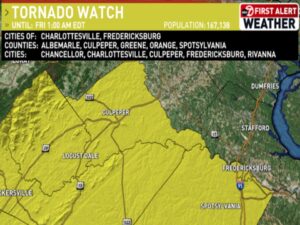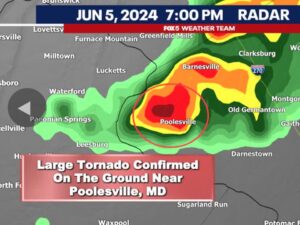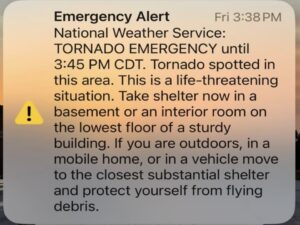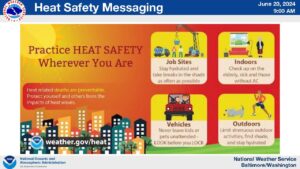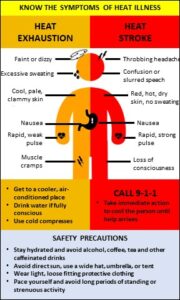Severe weather can have serious impacts on life safety, the campus environment, and University operations. Know if severe weather is threating campus by registering for UMBC alerts at https://police.umbc.edu/emergency-preparedness/umbc-alerts/. Watch for a SHELTER-IN-PLACE alert and know where to go for safety.
- Learn where interior shelter areas are located. Review our Facility Emergency Action Plans for campus buildings.
- Seek shelter in interior corridors, interior stairwells, and internal spaces on the basement or ground level.
- Stay away from exterior doors and windows and away from open areas like lobbies or vestibules.
Tornados
The National Weather Service (NWS) uses three types of tornado alerts: a TORNADO WATCH, a TORNADO WARNING, and a TORNADO EMERGENCY. Visit the NWS webpage to learn more. To prepare for a possible tornado alert on campus:
Tornado Watch – Be Prepared!
A WATCH means weather conditions in your area could produce a tornado.
- A watch area is typically large, covering numerous counties or even states.
- Be ready to act quickly if a warning is issued or you suspect a tornado is approaching.
- Acting early helps to save lives!
Plan ahead for tornado emergencies.
- Pick a safe room in your home, such as a basement, storm cellar, or an interior room on the lowest floor with no windows.
- Have a family plan that includes an emergency meeting place and related information. If you live in a mobile home or home without a basement, identify a nearby safe building you can get too quickly, like a church or a neighbor’s home.
- Make sure all members of your family know to go there when tornado warnings are issued.
- Don’t forget your pets.
- Help your neighbors and encourage your loved ones to prepare for tornado emergencies.
Tornado Warning – Take Action!
A WARNING means there is immediate danger to life and property.
- Warnings occur when a trained spotter has seen a tornado on the ground or a forecaster has identified a tornado on radar.
- The warning area is typically much smaller than a tornado watch area.
- Warnings impact areas the size of a city or small county.
- Move to an interior room on the lowest floor of a sturdy building.
- Avoid windows and protect yourself from flying debris.
Take action! Listen to local news to stay updated about tornado watches and warnings.
- On UMBC’s campus: Go to your building’s Interior Shelter Area. Avoid windows and large open rooms like cafeterias, gymnasiums, or auditoriums.
- At home: If you are in a tornado warning area, go to your basement, safe room, or an interior room away from windows. Don’t forget your pets.
- Outside: Seek shelter inside a sturdy building immediately. Sheds and storage facilities are not safe.
- In a vehicle: Do not attempt to outrun a tornado. Being in a vehicle during a tornado is not safe. Drive to the closest shelter. If you are unable to make it to a safe shelter, get down in your car and cover your head, or abandon your car and seek shelter in a low lying area such as a ditch or ravine.
Tornado Emergency – Seek Shelter Immediately!
A tornado EMERGENCY is the highest alert level. An emergency alert means a violent tornado has touched down in the alert area.
- There is a severe threat to human life and property.
- Catastrophic damage is confirmed.
- Immediately seek refuge in the safest location possible.
- Call friends and family who are within the alert area to ensure they are aware of the situation.
After a tornado emergency ends.
- Keep listening to local news to stay updated about tornado watches and warnings. Severe thunderstorms can produce multiple rounds of tornadoes.
- Let your family and friends know your are okay. Text messages or social media are more reliable forms of communication than phone calls.
- After the tornado threat is over, check to see if your property has been damaged or if anyone is injured.
- Stay out of damaged buildings.
- If you find people that are injured and you are properly trained, provide first aid if needed until emergency response teams arrive.
- Do not go near downed power lines. Report downed power lines to the police.
- Beware of insurance scammers. Report any suspicious phone calls or emails to your insurance company.
Heat Emergencies and Heat Safety
Click on the images below for heat safety precautions.
Ensure you are taking proper precautions during severe heat:
- Consider cancellation of outdoor events.
- Limit outdoor work.
- Monitor workers at jobsites.
- Conduct regular checks of air conditioning systems and monitor sensitive equipment.
- Practice vehicle safety – look before you lock.
Know the symptoms of heat illness: Heat exhaustion and heat stroke occur when the body is not able to effectively cool itself. Both occur in high temperatures or during intense physical exertion.
- HEAT EXHAUSTION: Heat exhaustion occurs when core body temperature is elevated but remains below 104°F. Heat exhaustion can lead to heat stroke if left untreated.
- Symptoms of heat exhaustion: Dizziness, headache, nausea, weakness, unsteady gait, muscle cramps, heavy sweating, fast and weak pulse, and rapid breathing.
- HEAT STROKE: Heat stroke is a life-threatening condition that occurs when the body can’t regulate its temperature and overheats. The body’s temperature can rise to 104°F or higher within 10 to 15 minutes, and the body’s sweating mechanism fails. Without immediate medical attention, heat stroke can cause permanent damage to the brain and other vital organs, leading to coma, organ failure, or death.
- Symptoms of heat stroke: Confusion, seizures, loss of consciousness, red, hot, dry skin, throbbing headache, nausea and vomiting.
Treating heat illness: Reduce the person’s body temperature. Move them to a cool, shaded area and remove excess clothing. Mist cool water on the person while fanning warm air over them to cause the water to evaporate and cool their skin. Apply cool water, wet towels, or ice packs. If the person is conscious provide water. If they lose consciousness begin CPR.
Personal heat safety precautions:
- Stay hydrated and avoid alcohol, coffee, tea and other caffeinated drinks.
- Avoid direct sun, use a wide hat, umbrella, or tent.
- Wear light, loose fitting protective clothing.
- Pace yourself and avoid long periods of standing or strenuous activity.
Winter Storms
More information coming soon.
Other Severe Weather Conditions
More information coming soon.
